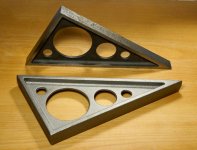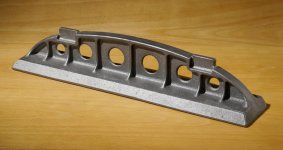

I've seen Gary Martin's castings mentioned several times on this forum, but since these straight edges are not yet on his web site, I thought the attached photos might be of interest to the members of this forum. His contact information is on his website at http://www.martinmodel.com/
Gary is an independent patternmaker and sells castings of engine kits, flywheels for model engines, pattern filer kits, etc., as a sideline to his patternmaking business. He is located in Scappoose, Oregon.
I photographed the straight edge for Gary, and also some angles that might be of interest to folks looking for scraping projects. The castings are fully annealed and ready for machining - they obviously will need additional heat treatment for stress relief before scraping.
The 18" straight edge casting sells for $95, and the 30/60/90 angle (nominally 7"x12"x14") for $50. Plus shipping, but I think he told me that shipping is usually less than $20. I think he has four or five straight edge castings and three or four of the angles.
Full disclosure - I'm not involved with Gary's business in any way, although I helped him out with some of his photography as a favor. I occasionally attend his Thursday night patternmaking workshop. I made the pattern for the 30/60/90 angle at the workshop.
Douglas



